Rigel, Beta Orionis (β Ori), is a blue-white supergiant star located approximately 848 light-years away in the constellation Orion, the Hunter. With an apparent magnitude of 0.13, it is the brightest star in Orion and the seventh brightest star in the sky.
Rigel is one of the most luminous stars visible to the unaided eye. The blue supergiant marks the foot of Orion. It outlines the celestial Hunter’s familiar constellation figure with Betelgeuse, Bellatrix, Saiph, and the stars of Orion’s Belt (Alnitak, Alnilam, and Mintaka).
Rigel is a variable star. Its brightness has been observed to vary between magnitudes 0.05 and 0.18. This means that it is sometimes fainter than its Orion neighbour Betelgeuse (Alpha Orionis) and at other times it outshines Capella (Alpha Aurigae) to become the sixth brightest star in the sky.
Star system
Rigel appears as a single star to the unaided eye, but is in fact a multiple star system that consists of at least four components. The components are designated Beta Orionis A (Rigel), Beta Orionis Ba, Beta Orionis Bb, and Beta Orionis C. The three fainter components (Rigel Ba, Bb and C) are sometimes simply called Rigel B. Rigel B and Rigel C are commonly referred to as Rigel BC.
There is another star, fainter and at wider separation, that may be part of the Beta Orionis system. It appears almost an arcminute away from Rigel.
Rigel A (or simply Rigel) is a luminous blue supergiant star with 21 times the Sun’s mass. It is separated from the fainter triple star system by 9.5 arcseconds. It is 440 times brighter than Rigel BC. It has an average apparent magnitude of 0.13, while Rigel BC shines at magnitude 6.67, just below unaided eye visibility.
Rigel B is a spectroscopic binary system. The individual components – Rigel Ba and Rigel Bb – are too close together and cannot be resolved visually, even with the largest telescopes. The binary nature of the system can only be detected through the double star’s spectral lines.
Rigel B and Rigel C can be resolved, but only with telescopes with very high resolving power.
Rigel BC takes about 24,000 years to complete an orbit around Rigel A, while the components B and C orbit each other with a period of about 63 years. Rigel Ba and Rigel Bb have a considerably shorter orbital period. They complete an orbit around a common centre of mass every 9.860 days.
The properties of the components Rigel Ba, Ba and C are difficult to determine because of the stars’ proximity to each other. All three appear to be blue-white main sequence stars of the spectral type B9 V, with similar temperatures. Their estimated masses are also similar at 3.84, 2.94, and 3.84 solar masses respectively.
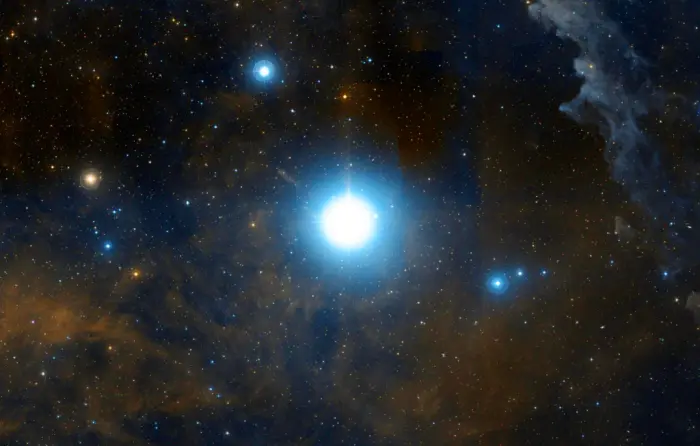
Rigel in Orion. Image created using the Aladin Sky Atlas software from the Strasbourg Astronomical Data Center and DSS (Digitized Sky Survey) data. DSS is one of the programs of STScI (Space Telescope Science Institute) whose files are in the public domain. Credit: Roberto Mura (CC BY-SA 4.0)
Rigel A
Rigel (Beta Orionis A) is a massive, luminous star of the spectral type B8 Ia, indicating a bright supergiant appearing blue or blue-white in colour. It has an estimated age of only 8 million years.
The star has a radius 74.1 times that of the Sun and an estimated mass of 21 solar masses. With a surface temperature of 12,100 K, it shines with about 120,000 solar luminosities. The supergiant’s exact luminosity is uncertain, but most estimates have been in the range from 61,500 to 363,000 L☉.
Rigel is classified as an Alpha Cygni variable. Like the fellow supergiant Deneb (Alpha Cygni), it exhibits small variations in brightness as a result of non-radial pulsations, with some parts of its surface contracting while others simultaneously expand.
A number of well-known stars belong to this class, including Alnilam in Orion, Aludra and Omicron2 Canis Majoris in Canis Major, Shaomin (Rho Leonis) in Leo, Sigma Cygni in Cygnus, and possibly Naos in Puppis, among others.
Rigel has exhausted the supply of hydrogen in its core and, as it evolved from the main sequence, it started to cool and expand to its current size. Based on the star’s pulsations, it is possible that it already was a blue supergiant once, before evolving into a red supergiant and then increasing its temperature and becoming a blue supergiant again.
Even though Rigel’s physical properties are uncertain, the star will face the same fate as other exceptionally massive stars, including most of its bright Orion neighbours. It will keep fusing increasingly heavier elements in its core until the core can no longer counter gravitational compression and implodes, triggering a Type II supernova.
Rigel is one of the nearest known supernova candidates to Earth. The only known supernova candidates that are closer are IK Pegasi in the constellation Pegasus, Spica in Virgo, Acrux A and B in Crux, Zeta Ophiuchi in Ophiuchus, Uridim (Alpha Lupi) in Lupus, Betelgeuse in Orion, Antares in Scorpius, and Pi Puppis in Puppis.
When Rigel goes out, the supernova will likely reach a visual magnitude of about -11, which is about as bright as a quarter Moon. However, it will not affect Earth because the star is too distant.
Rigel B
Beta Orionis B has an apparent magnitude of 6.7, just below unaided eye visibility (mag. 6.5). It would be easy to spot in small telescopes if it were not so close to the luminous Rigel. Since it is about 440 times fainter than its neighbour, Rigel B is difficult to see in telescopes with apertures smaller than 6 inches.
The binary system Beta Orionis Ba/Bb is separated from the primary component by 9.5 arcseconds, corresponding to a physical distance of more than 2,200 astronomical units (Earth – Sun distances). The system has a similar proper motion to the main star, Rigel A. Rigel and Rigel B have an orbital period of at least 18,000 years.
Rigel B is a double-lined spectroscopic binary star (SB2), which means that spectral lines from both components are visible. Based on the periodic changes in the lines, the two stars are believed to have an orbital period of 9.86 days. Both stars are hot and have a spectral classification of about B9. They are believed to form a triple star system with Rigel C.
Based on the data obtained in the Gaia Data Release 3, Rigel B has a parallax of 3.2352 ± 0.0553 milliarcseconds. This corresponds to a distance of around 1,000 light-years, which would place the system far beyond Rigel.
The data in the Gaia Data Release 2 placed the star even farther away. With a Gaia DR2 parallax of 2.9186 ± 0.0761 milliarcseconds, the binary star would lie approximately 1,100 light-years away. The distance would be consistent with membership in the Taurus-Orion R1 association. However, the Gaia parallax is considered to be unreliable in systems in which a bright source contaminates the flux of the target.
Rigel C
Rigel C is separated from Rigel B by less than 0.1 to 0.3 arcseconds. Observations in 2009 revealed that Rigel B and Rigel C had almost identical properties and were separated by only 0.124 seconds of arc. The stars have apparent magnitudes of 7.5 and 7.6 and orbit each other with a period of 63 years.
Luminosity
Rigel is classified as a class Ia luminous supergiant based on its hydrogen spectral lines. With an absolute magnitude of -7.84, it is one of the most luminous stars visible to the unaided eye. It is the second most luminous first magnitude star, after the supergiant Deneb in the constellation Cygnus.
If Rigel were located at the same distance from us as Sirius, it would have an apparent magnitude of about -10 and be a little dimmer than the full Moon (mag. -12.74).
Even though Rigel is often referred to as the most luminous star within 1,000 light years of Earth, the star’s luminosity is still uncertain. Based on the currently accepted distance of 848 light years, its estimated luminosity is about 120,000 times that of the Sun. However, a recent study gives a distance of 1,170 ± 130 light years, which yields a luminosity of 218,000 solar luminosities.
Calculations using stellar evolutionary models give luminosities in the range from 83,000 to 363,000 solar luminosities, while estimates based on angular diameter measurements from the Navy Precision Optical Interferometer, using the Hipparcos distance of 860 light years, indicate an energy output of 61,515 ± 11,486 solar luminosities.
Brightness
Rigel is the seventh brightest star in the sky. It is usually slightly fainter than Capella, but not always. Rigel’s brightness varies from magnitude 0.05 to 0.18 and Capella’s from 0.03 to 0.16 so Rigel occasionally outshines Auriga’s brightest star, briefly becoming the sixth brightest star in the sky.
Rigel’s variability has been known since at least 1930. However, the variations in the star’s brightness have a small amplitude and can only be detected photoelectrically or with CCD photometry. The variations do not have a clear period. A study conducted in 1984 revealed variations of up to 0.13 magnitudes over several hours to a few days, but with no apparent period.
In 1998, a study of B stars observed with the Hipparcos satellite presented a classification of new variable stars discovered by Hipparcos and Rigel was classified as an Alpha Cygni variable.
Alpha Cygni stars generally seem to have irregular variations because they are caused by pulsations. The pulsations can appear irregular because there are multiple pulsation periods. These periods typically last from several days to several weeks. The mechanism behind the pulsations is still not entirely understood.
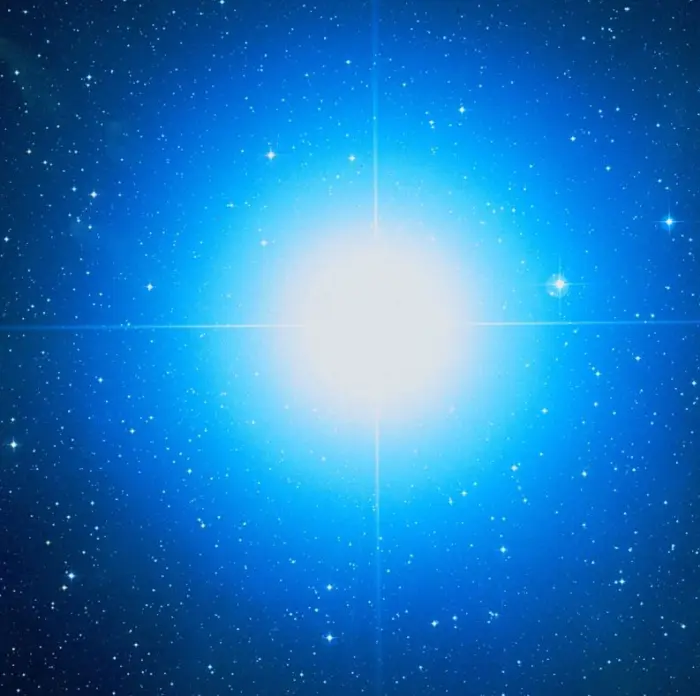
Rigel through Rutherfurd Observatory’s primary telescope. Credit: Wikimedia Commons/Haktarfone (CC BY-SA 3.0)
Mass
Rigel’s mass is also uncertain. A comparison of evolutionary tracks yielded a mass of 21 ± 3 solar masses at an age of 8 ± 1 million years. However, calculations based on atmospheric modelling from the star’s spectrum have produced a value of 24 ± 8 solar masses.
Rigel’s H-alpha emissions show a P Cygni profile, a spectroscopic feature that indicates the existence of an expanding shell of gas and a dense stellar wind, both associated with mass loss. However, the star shows a P Cygni profile only a quarter of the time and its line profiles transform every few days, sometimes indicating mass loss and at other times infalling material.
The changes have been explained as the result of varying quantity and velocity of the material lost from the star. A study published in 1997 suggests that the changes are due to Rigel having extended rotating magnetic structures emerging from its photosphere.
Based on observations of Rigel’s variable H-alpha line, the star is estimated to lose mass at a rate of (1.5 ± 0.4) × 10−7 solar masses per year, or 10 million times faster than the Sun. Later studies gave a mass loss rate of (9.4 ± 0.9) × 10−7 solar masses per year (2006-2007) and (7.6 ± 1.1) × 10−7 solar masses per year (2009-2010), based on observations of Rigel’s H-gamma line.
Rigel is believed to have lost about 3 solar masses from its initial mass of 24 ± 3 solar masses, which it had when it began its life 7 to 9 million years ago.
Colour
Like all class B supergiants, Rigel is very luminous and appears distinctly bluish in colour, in stark contrast to the red supergiant Betelgeuse.
Rigel serves as a spectral standard for its class, B8 Ia. Its spectrum shows neutral helium lines and strong hydrogen absorption lines, characteristic of its class, as well as heavier elements, including oxygen, magnesium, and calcium.
Distance
Rigel’s currently accepted distance of 848 light-years (260 parsecs) comes from a 2022 study that combined spectroscopy and spatial intensity interferometry measurements within Rigel’s Hα line. Astronomers calculated the distance based on a luminosity of 123,000 solar luminosities (derived from the data obtained with the Hipparcos satellite).
The previous distance of 863 light years, or 265 parsecs, was based on the 2007 Hipparcos reduction of the star’s parallax (3.78 ± 0.34 milliarcseconds). The margin of error was about 9%.
The Gaia Data Release 2 gave a parallax of 2.9186 ± 0.0761 milliarcseconds for one of Rigel’s fainter companion stars, which translates into a distance of 1,100 light years, or 340 parsecs. As the companion is a close binary system, the value may not be reliable.
Rigel’s distance has also been estimated through indirect measurements. The star illuminates the nearby Witch Head Nebula (IC 2118), which extends for about 5 degrees at an angular separation of 2.5 degrees (or 39 light-years) from the star. Distance measurements of the stars embedded within the nebula yielded a value of 949 ± 7 light-years, or 291 ± 2 parsecs.
Size
The measurements of Rigel’s angular diameter and size have produced different results. An older value given for the star’s angular diameter is 2.75 ± 0.01 milliarcseconds, which translates into a radius 78.9 times solar.
However, a study published in 2017 that used the Navy Precision Optical Interferometer to measure the star’s apparent size gave a value of 2.526 milliarcseconds for Rigel’s angular diameter and derived a radius of 74.1 solar radii (allowing for a margin of error in the range from 66.8 to 80.2 solar radii), close to the orbit of Mercury.
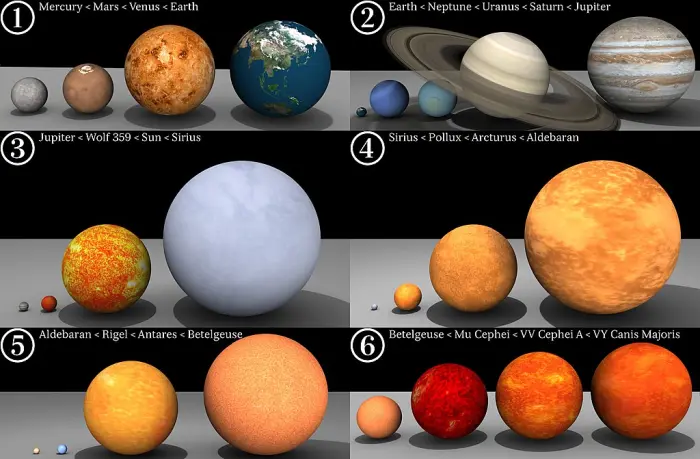
Relative sizes of the planets in the solar system and several well known stars. Credit: Dave Jarvis (CC BY-SA 3.0)
Temperature
Rigel’s estimated surface temperature is around 12,100 K based on the star’s colour and spectral class. That’s less than 50% compared to its temperature before it evolved off the main sequence. The supergiant’s effective temperature on the main sequence would have been around 30,000 K.
As the star exhausted its supply of hydrogen and evolved away from the main sequence, it began to expand and cool. It may have already passed through a cool red supergiant stage and then evolved towards hotter temperatures again.
Facts
Rigel is, on average, the seventh brightest star in the sky. It is slightly fainter than Vega in the constellation Lyra and Capella in Auriga, but outshines Procyon in Canis Minor, Achernar in Eridanus and (most of the time) its Orion neighbour Betelgeuse.
Rigel is the brightest of the seven stars that form the hourglass constellation figure of Orion. Saiph marks the Hunter’s other foot, Betelgeuse and Bellatrix mark the shoulders, and Alnitak, Alnilam and Mintaka form the Belt of Orion, one of the best-known asterisms in the night sky.
Rigel has the Bayer designation Beta Orionis even though most of the time it is brighter than the red star Betelgeuse, which has the designation Alpha. The German uranographer Johann Bayer, who assigned Greek letter designations to bright stars around the years 1600, was guided by the order of magnitude and not by individual brightness.
Orion is not the only constellation in which the brightest star is not designated Alpha. The brightest stars in Sagittarius, Ursa Major, Pegasus, Hercules and Gemini have the designations Epsilon Sagittarii, Epsilon Ursae Majoris, Epsilon Pegasi, Beta Herculis, and Beta Geminorum, respectively, and they are not the only examples. Bayer did not use the same scheme for every constellation, so it is possible that he used a different logic when assigning the letters to Orion stars.
However, since both Betelgeuse and Rigel are variable stars, it is also possible that when Bayer assigned the designations, Betelgeuse was in fact brighter than Rigel.
Rigel illuminates the reflection nebula IC 2118, also known as the Witch Head Nebula. The nebula’s appearance bears a striking resemblance to the head of a fairy tale witch. The nebula appears in the region between Rigel, Cursa (Beta Eridani) and Psi Eridani. It may be an ancient supernova remnant or a gas and dust cloud. It reflects the supergiant’s light and contains molecular clouds, which are sites of star formation.
The Witch Head Nebula lies in the constellation Eridanus (the River), which stretches from Orion’s foot all the way into the far southern sky, where the bright Achernar (invisible to most northern observers) marks the River’s end.
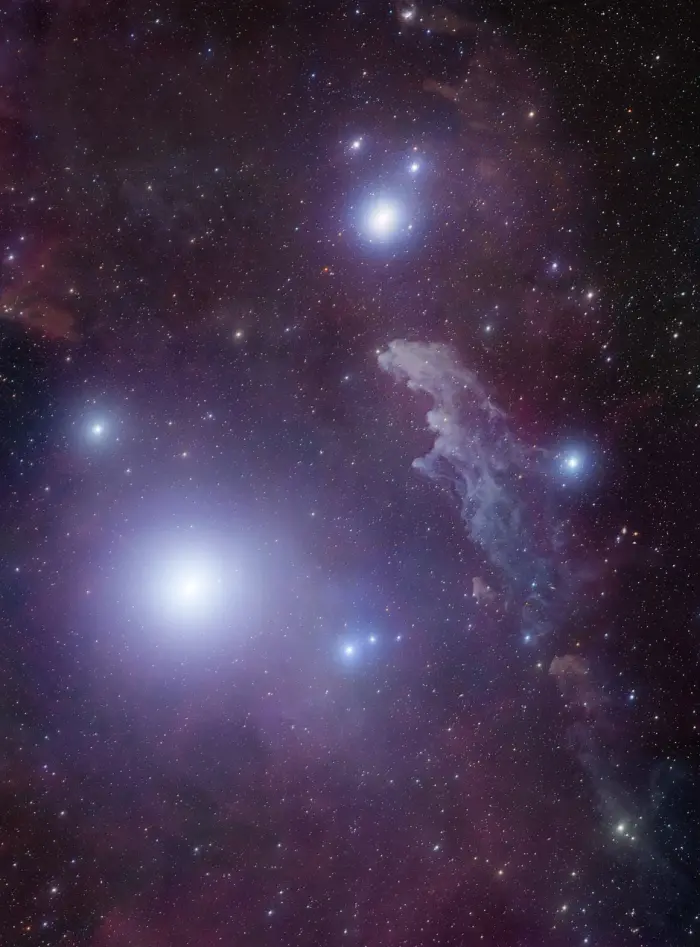
Supergiant Rigel and IC 2118 in Eridanus. Image credit: ESO, Robert Gendler (CC BY 4.0)
Rigel marks one of the vertices of the Winter Hexagon (or the Winter Circle), a large asterism that dominates the evening sky during the northern hemisphere winter. Other vertices of the Winter Hexagon are marked by Aldebaran in Taurus, Capella in Auriga, Pollux in Gemini, Procyon in Canis Minor and Sirius in Canis Major, the brightest star in the sky. Capella is part of a smaller hexagon formed by the brightest stars in Auriga with Elnath in Taurus.
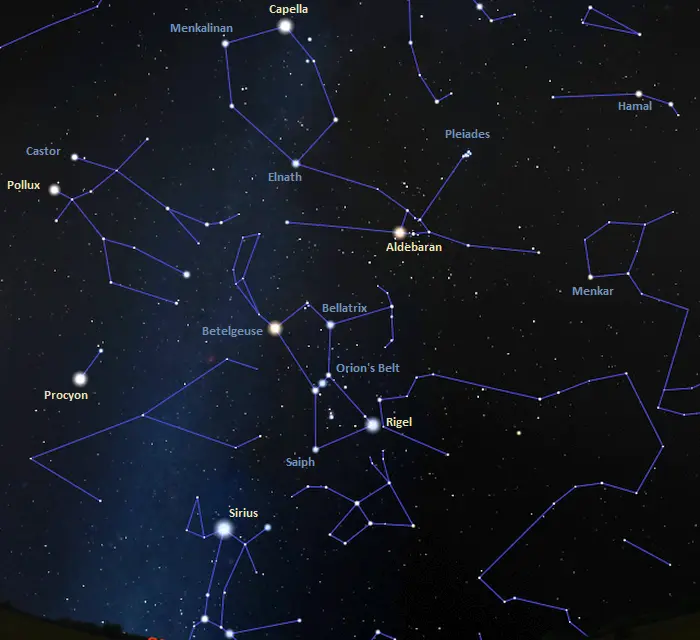
The stars of the Winter Hexagon: Rigel, Sirius, Procyon, Pollux, Capella, and Aldebaran, image: Stellarium
Rigel is one of the 58 stars selected by Her Majesty’s Nautical Almanac Office and the US Naval Observatory for navigation. It is one of four navigational stars in Orion. The other three are Betelgeuse and Bellatrix, the bright stars marking Orion’s shoulders, and Alnilam, the central star of Orion’s Belt.
Navigational stars are some of the brightest stars in the sky. They were selected for use in celestial navigation because they are easy to identify, both because they are bright and because they are part of recognizable asterisms and constellation figures. Rigel, Betelgeuse and Bellatrix are part of the constellation figure of Orion, and Alnilam is the brightest of the three stars of Orion’s Belt.
Rigel has been known to be a multiple star system for over two centuries. The German-born British astronomer William Herschel discovered it to be a double star on October 1, 1781. He entered it as star 33 (H II 33) in his Catalogue of Double Stars.
Baltic German astronomer Friedrich Georg Wilhelm von Struve was the first to measure the relative position of Rigel’s companion in 1822. The catalogued the two visual components as Σ 668.
In 1871, American astronomer Sherburne Wesley Burnham suspected Beta Orionis B to be a binary star and was able to resolve it into two stars in 1878. The second star spotted by Burnham is now designated as Rigel C. Burnham entered Rigel as β 555 (the modern BU 555) in his catalogue of double stars.
In 1878, Burnham also observed another suspected companion, a 13th magnitude star, and catalogued it as component D of β 555. The star was separated by 44.5 arcseconds from Rigel in 2007. Whether or not it is a member of the Beta Orionis system is still uncertain. The Gaia Data Release 2 identified it as a Sun-like star, likely an orange dwarf, of 12th magnitude, located at about the same distance as Rigel. If it is a member of the Rigel star system, its estimated orbital period is about 250,000 years.
Rigel is considered to be an outlying member of the Orion OB1 association, which lies at a distance of up to 1,600 light-years. The supergiant is a member of the Taurus-Orion R1 Association, a loose group of stars that share a common origin and motion through space, located about 1,200 light years, or 360 parsecs, from the solar system. Rigel lies much closer than most members of Orion OB1, but farther away than Betelgeuse and Saiph.
Variations in Rigel’s radial velocity (the speed at which it moves relative to Earth) were first detected in 1888. The star’s radial velocity was later confirmed to vary by about 10 km/s.
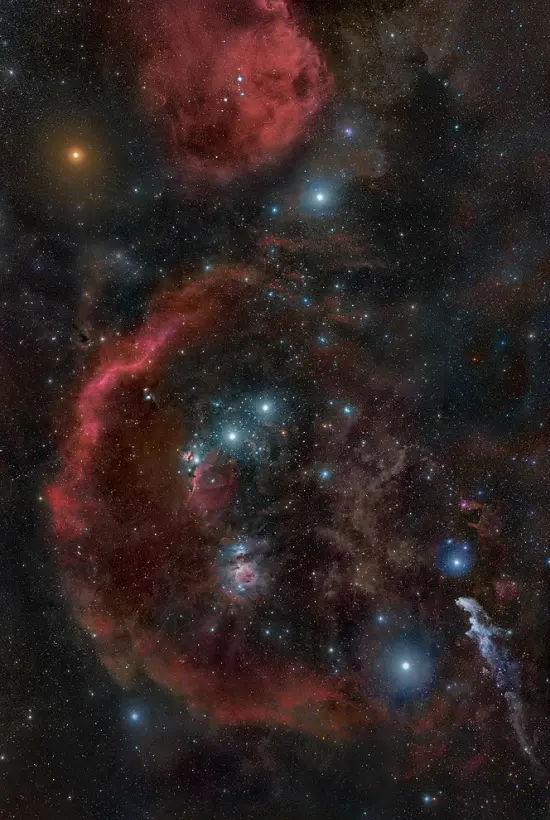
The constellation Orion, image credit: Rogelio Bernal Andreo (CC BY-SA 3.0)
Mythology and culture
Like many other exceptionally bright stars, Rigel had cultural and historic significance in many countries around the world.
In Japan, it was chosen to represent the Genji clan, one of the four major clans during the Heian period (794-1185). The star was called Genji-boshi (源氏星). The rivalling Taira clan chose Betelgeuse and its red colour as their symbol.
The two clans fought the Genpei War and Rigel and Betelgeuse were seen as facing off against each other in the sky, with only the Orion’s Belt stars keeping them apart. Rigel was also called Gin-waki (銀脇), meaning “the silver star beside Mitsu-boshi (Orion’s Belt).”
Rigel may be the star marking “Orwandil’s toe” in Norse mythology. In the myth, Orwandil (or Aurvandil), the Giant, was frostbitten and the god Thor broke off his frozen toe and threw it into the sky. Since the broken off toe is more commonly associated with Alcor in Ursa Major, Richard Hinckley Allen suggested that Alcor was the frost-bitten toe and Rigel was the other toe in his Star Names: Their Lore and Meaning (1889).
In Caribbean lore, Rigel marked the severed leg of Trois Rois, a man who loved the daughter of a woman who disliked him. As the lovers took flight, the mother ran after them and managed to cut off one of his legs. The daughter is represented by Aldebaran, Trois Rois by the stars of Orion’s Belt, and the mother by Sirius.
Two places in Antarctica were named after Rigel: the Rigel Skerries and Mount Rigel.
Rigel has been used in countless works of fiction, including multiple episodes of Star Trek and the films Star Trek: The Motion Picture (1979) and Fantastic Four: Rise of the Silver Surfer (2007). Notable uses of the star in literature include M. A. R. Barker’s Tékumel novels and games, the novels Next of Kin (1959) by Eric Frank Russell, Jack Vance’s Demon Princes series (1964-1981), and Timothy Zahn’s Night Train to Rigel (2005).
Name
The name Rigel (pronunciation: /ˈraɪdʒəl/) comes from the Arabic phrase Rijl Jauzah al Yusrā, meaning “the left leg of the central one,” and refers to the star’s position at the foot or leg of Orion. Jauzah was the Arabic name for the constellation Orion. It referred to a female figure whose identity is uncertain. The name Rigel was also spelled as Regel, Riglon, Algibbar and Rigel Algeuze.
The less common names for the star were Algebar or Elgebar, derived from the Arabic riǧl al-ǧabbār, meaning “the foot of the great one.”
The name Rigel dates back to the 10th century. The earliest known written mention of it is in the Alfonsine Tables of 1521.
The International Astronomical Union’s (IAU) Working Group on Star Names (WGSN) officially approved the name Rigel for Beta Orionis A on June 30, 2016. Even though the name formally applies only to the brightest component, it is commonly used for the entire star system and its individual components (Rigel A, Rigel B, and Rigel C).
Rigel has been known by many different names across different cultures. The Chinese know it as the Seventh Star of Three Stars, referring to the Chinese Three Stars (參宿) asterism. The asterism originally consisted of the three stars of Orion’s Belt, but was later expanded to include the four other bright stars of Orion.
The Lacandon people of Mexico called Rigel tunsel, meaning “the little woodpecker.”
The Wotjobaluk koori of Victoria in Australia knew the star as Yerrerdet-kurrk. Rigel represented the mother-in-law of Totyerguil (Altair). The distance between the two stars symbolized the taboo of a man approaching his mother-in-law.
The Boorong people of Victoria called Rigel Collowgullouric Warepil, while the Wardaman people of the Northern Territory knew it as the Red Kangaroo Leader Unumburrgu, who led ceremonies when the constellation Orion was high in the sky. The other bright stars of Orion represented his tools and followers.
The Māori people of New Zealand knew Rigel as Puanga, a daughter of Rehua, the chief of all stars, represented by Antares. Rigel’s heliacal rising heralded the appearance of the Pleiades, known as Matariki, in the morning sky in late May or early June, symbolizing the Māori New Year.
Location
Rigel is easy to find because it is part of one of the most recognizable constellations in the sky. Marking the left foot of Orion, the star appears as the bottom right star of Orion’s hourglass figure to northern observers and as the top left star to observers in the southern hemisphere.
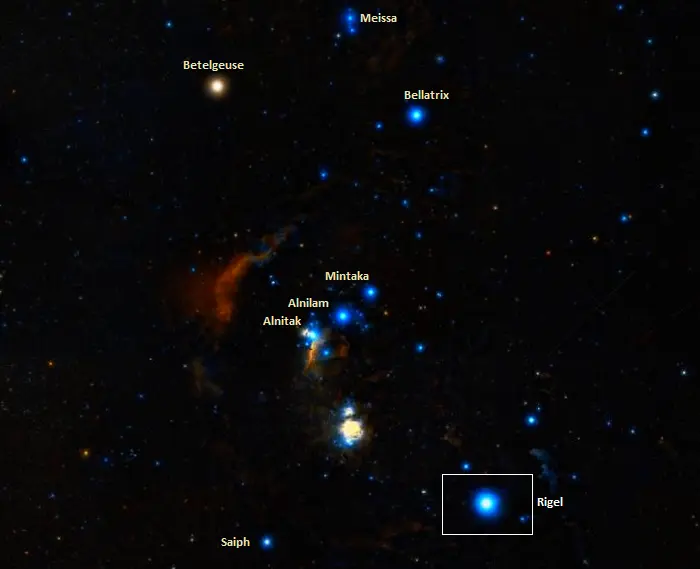
The location of Rigel (Beta Orionis), image: Wikisky (DSS2)
Rigel is located in the vicinity of several notable deep sky objects. The nearest one is the Witch Head Nebula (IC 2118), a faint reflection nebula illuminated by Rigel, located in the region between Rigel and Cursa, in the neighbouring constellation Eridanus. The faint H II region Sharpless 278 lies just north of Rigel. The Orion Nebula (Messier 42), which lies a bit further away and appears as the central star of Orion’s Sword, forms a triangle with Rigel and Saiph, Orion’s other foot.
Other deep sky objects that appear in the same region of the sky include the spiral galaxies IC 402, NGC 1752 and NGC 1720, and the lenticular galaxy NGC 1726.
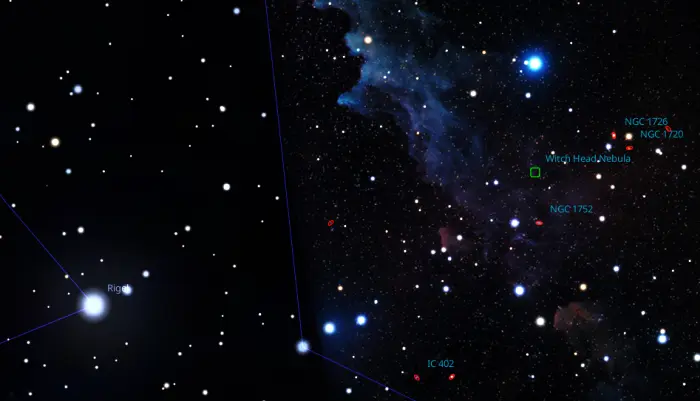
Deep sky objects near Rigel, image: Stellarium
Rigel can be used to find the constellation Lepus (the Hare), which appears just south of Orion’s feet. An imaginary line drawn from Rigel through Betelgeuse points in the direction of Castor, the second brightest star in Gemini (the Twins).
At declination −08° 12′, Rigel can be seen from all locations on Earth except those within 8 degrees of the North Pole. It is at its highest point in the sky at midnight on December 12 and at 9 pm on January 24.
Constellation
Rigel is located in the constellation Orion, the Hunter. Named after the Greek mythical hunter, Orion is one of the brightest constellations in the sky. It stretches across 594 square degrees of the sky on the celestial equator and is the 26th largest constellation in the sky.
Orion is one of the oldest constellations. Known to observers since prehistoric times, it is one of the 48 constellations catalogued by Claudius Ptolemy of Alexandria in his Almagest in the 2nd century CE. In Greek mythology, it is associated with Orion, a giant huntsman known for his supernatural strength. In Greek lore, Orion boasted about doing away with every single animal on Earth, which angered the goddess Gaia. Gaia then sent a scorpion (represented by the constellation Scorpius) to sting the hunter. In other versions, he met his end by the bow of the goddess Artemis. It is said that the god Zeus placed Orion among the constellations.
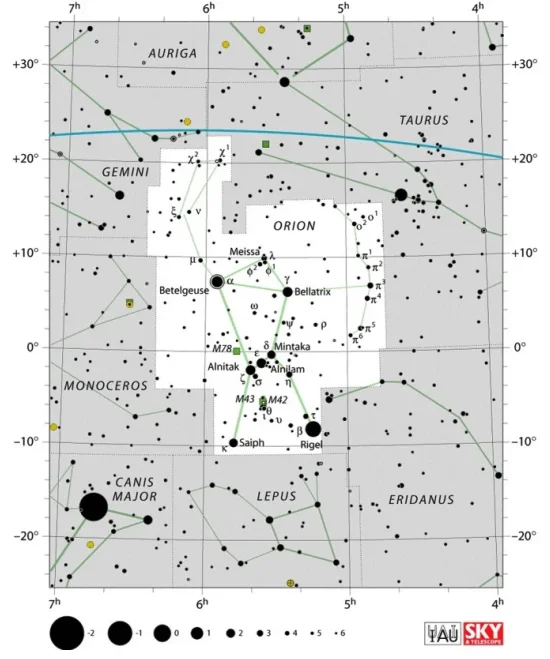
Orion constellation map by IAU and Sky&Telescope magazine (Roger Sinnott & Rick Fienberg) (CC BY 3.0)
Rigel marks the huntsman’s left foot, possibly the one stung by the scorpion. The nearby Cursa (Beta Eridani), the second brightest star in Eridanus, represents Orion’s footstool.
Orion hosts many exceptionally luminous and massive stars that will end their lives as brilliant supernovae. These include the red supergiant Betelgeuse (Alpha Orionis), blue supergiants Rigel (Beta Orionis), Saiph (Kappa Orionis), Alnitak (Zeta Orionis), and Alnilam (Epsilon Orionis), the bright giant Mintaka (Delta Orionis), and giants Meissa (Lambda Orionis) and Hatysa (Iota Orionis). The hot blue star Bellatrix (Gamma Orionis) is the only one among Orion’s seven brightest stars that may not be massive enough to be a supernova candidate.
The constellation is known for its two familiar asterisms, Orion’s Belt and Orion’s Sword. Orion’s Sword contains the bright, large Orion Nebula (M42) with the young Trapezium Cluster, the neighbouring De Mairan’s Nebula (M43), and the Running Man Nebula (Sharpless 279). Orion is also home to the reflection nebulae Messier 78 and NGC 1999, the dark Horsehead Nebula, and the emission nebulae NGC 2174 (the Monkey Head Nebula), NGC 2024 (the Flame Nebula), and Barnard’s Loop (Sharpless 276).
The best time of the year to see Rigel and other stars in Orion is during the month of January, when the constellation appears higher above the horizon in the early evening. Orion dominates the evening sky from January to March.
Orion dominates the evening sky from January to March. The 10 brightest stars in the constellation are Rigel (Beta Ori, mag. 0.05 – 0.18), Betelgeuse (Alpha Ori, mag. 0.0 – 1.3), Bellatrix (Gamma Ori, mag. 1.59 to 1.64), Alnilam (Epsilon Ori, mag. 1.64 – 1.74), Alnitak (Zeta Ori, mag. 2.00), Saiph (Kappa Ori, mag. 2.09), Mintaka (Delta Ori, mag. 2.23), Hatysa (Iota Ori, mag. 2.77), Tabit (Pi3 Ori, mag. 3.16), and Eta Orionis (mag. 3.31 – 3.6).
Rigel – Beta Orionis
| Absolute magnitude | -7.84 |
| Distance | 848 ± 65 light years (260 ± 20 parsecs) |
| Parallax | 3.78 ± 0.34 mas |
| Radial velocity | 17.8 ± 0.4 km/s |
| Proper motion | RA: +1.31 mas/yr |
| Dec.: +0.50 mas/yr | |
| Constellation | Orion |
| Designations | Rigel, Beta Orionis, β Ori, ADS 3823, H II 33, BU 555, STF 668, IDS 05097-0819, WDS J05145-0812, CCDM J05145-0812 |
Rigel A
| Spectral class | B8 Ia |
| Variable type | Alpha Cygni |
| U-B colour index | -0.66 |
| B-V colour index | -0.03 |
| Apparent magnitude | 0.13 (0.05 – 0.18) |
| Mass | 21 ± 3 M☉ |
| Luminosity | 120,000 L☉ (99,000 – 145,000 L☉) |
| Radius | 74.1 R☉ (66.8 – 80.2 R☉) |
| Temperature | 12,100 ± 150 K |
| Metallicity | −0.06 ± 0.10 |
| Age | 8 ± 1 million years |
| Rotational velocity | 25 ± 3 km/s |
| Surface gravity | 1.75 ± 0.10 cgs |
| Right ascension | 05h 14m 32.27210s |
| Declination | -08° 12′ 05.8981” |
| Designations | Rigel, Beta Orionis A, β Ori A, 19 Orionis, HR 1713, HD 34085, HIP 24436, FK5 194, BD-08°1063, SAO 131907, CSV 100463, GC 6410, GCRV 3110, GN 05.04.0, NSV 1882, PLX 1191.00, MCW 291, PPM 187839, GSC 05331-01752, PMC 90-93 140, HGAM 376, CEL 579, N30 1120, TD1 4253, ALS 14772, RAFGL 710, SACS 113, JP11 1014, 1RXS J051431.5-081112, AAVSO 0509-08, 2E 1238, 2E 0512.1-0814, WEB 4731, TIC 231308237, UBV 5016, UBV M 10750, VDB 36, IRAS 05121-0815, 2MASS J05143226-0812060, TYC 5331-1752-1 |
Rigel BC
| Spectral class | B9V + B9V |
| Apparent magnitude | 6.67 (7.5/7.6) |
| Mass (Rigel Ba, Bb, C) | 3.84 M☉, 2.94 M☉, 3.84 M☉ |
| Right ascension | 05h 14m 32.049s |
| Declination | -08° 12′ 14.78” |
| Designations (Rigel B) | Rigel B, Beta Orionis B, β Ori B, GCRV 3111, DENIS J051432.0-081214, WEB 4733, Gaia DR2 3206991473643150464, Gaia DR3 3206991473643150464 |